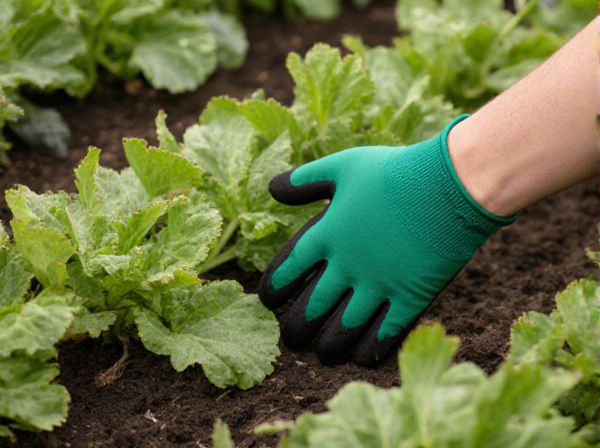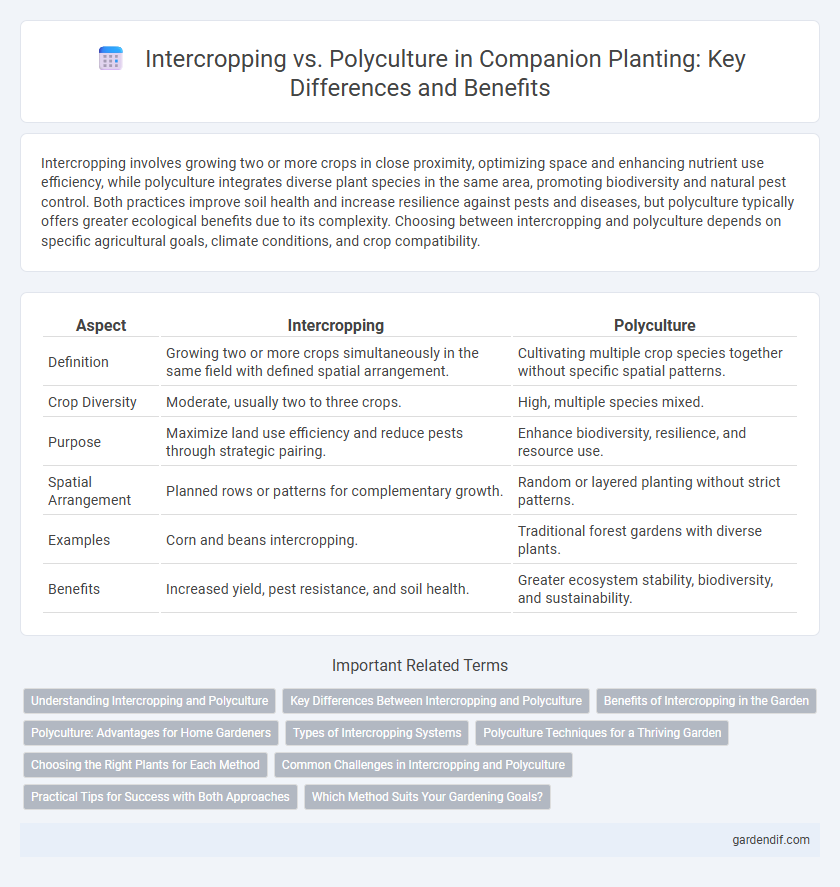
Intercropping vs polyculture Illustration
Intercropping involves growing two or more crops in close proximity, optimizing space and enhancing nutrient use efficiency, while polyculture integrates diverse plant species in the same area, promoting biodiversity and natural pest control. Both practices improve soil health and increase resilience against pests and diseases, but polyculture typically offers greater ecological benefits due to its complexity. Choosing between intercropping and polyculture depends on specific agricultural goals, climate conditions, and crop compatibility.
Table of Comparison
| Aspect | Intercropping | Polyculture |
|---|---|---|
| Definition | Growing two or more crops simultaneously in the same field with defined spatial arrangement. | Cultivating multiple crop species together without specific spatial patterns. |
| Crop Diversity | Moderate, usually two to three crops. | High, multiple species mixed. |
| Purpose | Maximize land use efficiency and reduce pests through strategic pairing. | Enhance biodiversity, resilience, and resource use. |
| Spatial Arrangement | Planned rows or patterns for complementary growth. | Random or layered planting without strict patterns. |
| Examples | Corn and beans intercropping. | Traditional forest gardens with diverse plants. |
| Benefits | Increased yield, pest resistance, and soil health. | Greater ecosystem stability, biodiversity, and sustainability. |
Understanding Intercropping and Polyculture
Intercropping involves growing two or more crops in proximity to maximize space and improve resource use efficiency, enhancing pest management and increasing overall yield. Polyculture incorporates diverse plant species in the same area, creating a resilient ecosystem that supports soil health and biodiversity. Both practices contribute to sustainable agriculture by optimizing companion planting benefits and reducing reliance on chemical inputs.
Key Differences Between Intercropping and Polyculture
Intercropping involves growing two or more crops simultaneously on the same field with distinct row arrangements, enhancing resource utilization and pest management. Polyculture combines diverse plant species in a single area without specific spatial separation, promoting biodiversity and resilience. Key differences lie in the spatial organization and crop diversity strategies, where intercropping focuses on planned crop sequencing and polyculture emphasizes mixed species integration.
Benefits of Intercropping in the Garden
Intercropping enhances garden productivity by maximizing space through the cultivation of complementary crops, which reduces pest incidence and improves soil health. This planting strategy promotes efficient nutrient use, water conservation, and increased biodiversity, leading to sustainable growth and higher yields. Compared to polyculture, intercropping offers more structured crop combinations that optimize resource allocation and minimize competition among plants.
Polyculture: Advantages for Home Gardeners
Polyculture offers home gardeners increased biodiversity, which enhances pest control and soil health through natural ecological interactions. This method maximizes space by cultivating multiple compatible plants together, resulting in higher yields and reduced risk of crop failure. Incorporating polyculture in home gardens also promotes sustainable practices by minimizing the need for chemical inputs and improving resilience to environmental stresses.
Types of Intercropping Systems
Intercropping systems include mixed intercropping, row intercropping, and relay intercropping, each designed to optimize spatial and temporal resource use among companion plants. Mixed intercropping grows two or more crops simultaneously without distinct row arrangement, enhancing biodiversity and pest resistance. Row intercropping involves alternating rows of different crops to maximize sunlight and soil nutrients, while relay intercropping staggers planting times to extend growing seasons and improve overall yield stability.
Polyculture Techniques for a Thriving Garden
Polyculture techniques enhance garden biodiversity by integrating multiple plant species in the same space, which improves pest resistance and soil health. This method promotes a dynamic ecosystem where companion plants support each other's growth through complementary nutrient use and natural pest deterrence. Utilizing polyculture encourages sustainable gardening practices that lead to higher yields and increased resilience against environmental stressors.
Choosing the Right Plants for Each Method
Choosing the right plants for intercropping involves selecting complementary species that maximize space and nutrient use, such as pairing deep-rooted crops with shallow-rooted ones. Polyculture emphasizes biodiversity by integrating multiple plant varieties that support pest control, pollination, and soil health simultaneously. Both methods rely on understanding plant compatibility and growth requirements to enhance yield and ecosystem sustainability.
Common Challenges in Intercropping and Polyculture
Common challenges in intercropping and polyculture include managing crop competition for sunlight, water, and nutrients, which can reduce overall yield if not optimized. Pest and disease control becomes complex due to diverse plant species creating microenvironments favorable to certain pests. Efficient spatial arrangement and timing are critical to harmonize growth cycles and maximize mutual benefits among companion plants.
Practical Tips for Success with Both Approaches
Intercropping and polyculture success depends on selecting compatible plant species that enhance nutrient uptake, pest control, and growth. Emphasize soil health by rotating crops and using organic mulch to maintain moisture and reduce weeds. Monitor plant spacing carefully to optimize light exposure and airflow, preventing disease and promoting vigorous growth.
Which Method Suits Your Gardening Goals?
Intercropping maximizes space efficiency by growing complementary crops in alternating rows, enhancing pest control and nutrient use, making it ideal for gardeners seeking high yields and crop diversity. Polyculture integrates multiple plant species in the same area, promoting biodiversity, soil health, and resilience against pests, suitable for sustainable and ecological gardening goals. Choose intercropping for structured, yield-focused gardens and polyculture for natural, ecosystem-based cultivation.
Intercropping vs polyculture Infographic

 gardendif.com
gardendif.com